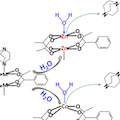Abstract
Instability of most prototypical metal organic frameworks (MOFs) in the presence of moisture is always a limitation for industrial scale development. In this work, we examine the dissociation mechanism of microporous paddle wheel frameworks M(bdc)(ted)0.5 [M = Cu, Zn, Ni, Co; bdc = 1,4-benzenedicarboxylate; ted = triethylenediamine] in controlled humidity environments. Combined in situ IR spectroscopy, Raman, and Powder X-ray diffraction measurements show that the stability and modification of isostructual M(bdc)(ted)0.5 compounds upon exposure to water vapor critically depend on the central metal ion. A hydrolysis reaction of water molecules with Cu–O–C is observed in the case of Cu(bdc)(ted)0.5. Displacement reactions of ted linkers by water molecules are identified with Zn(bdc)(ted)0.5 and Co(bdc)(ted)0.5. In contrast,. Ni(bdc)(ted)0.5 is less susceptible to reaction with water vapors than the other three compounds. In addition, the condensation of water vapors into the framework is necessary to initiate the dissociation reaction. These findings, supported by supported by first principles theoretical van der Waals density functional (vdW-DF) calculations of overall reaction enthalpies, provide the necessary information for determining operation conditions of this class of MOFs with paddle wheel secondary building units and guidance for developing more robust units.
